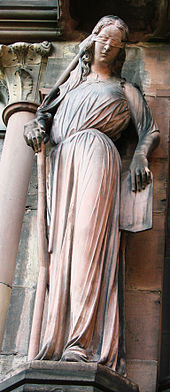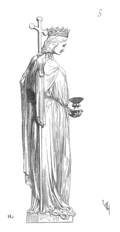Ecclesia and Synagogue
Ecclesia and Synagogue , also Ecclesia and Synagoga , are two allegorical female figures who, personified in the Christian iconography of the Middle Ages, symbolized Christianity and Judaism . According to the scheme of type and antitypus , they were usually compared in pairs.
Meaning and origin of the designations
The name of the figure Ecclesia is a church Latin derivation from the ancient Greek term for people's assembly ( ancient Greek ἐκκλησία ekklēsía , Ekklesie) and was first transferred to the local Christian community and, in the Middle Ages, to the church building and Christianity as a whole.
The figure name synagogue is derived from its original meaning, which, especially in the Middle Ages , encompassed not only the Jewish sacred building , but also the Jewish community and Judaism as a whole. The origin of the word goes back to an ancient Greek term for "assembly". It is sometimes mistakenly assumed that the allegorical figure, in contrast to the building, must be called a “synagogue”. Synagogue is only a Latinization of the word synagogue, both are synonymous and have the same multiple meanings.
Symbolism of representation
The two figures are the artistic expression of substitution theology and show the medieval understanding of the relationship between Christianity and Judaism , which was characterized by the strong feeling of superiority of the Christian church over Judaism.
According to another medieval interpretation, the Ekklesia represents the New Testament gospel and the synagogue represents the Old Testament law . The pair of figures of Ecclesia and synagogue usually flanked a representation of Jesus in the arched field in the usual arrangement on the portals of churches . The church portal is characterized iconographically as the door of heaven or salvation. With reference to the Jesus parable of the wise and foolish virgins ( Matthew 25 : 1–13 EU ), the two female figures are to be interpreted as "Brides of Christ". While the Ecclesia appears prepared for the heavenly wedding feast , the synagogue turns away in blind incomprehension. Even if blind to the Christian salvation event, according to the New Testament understanding the Messiah, who is true from a Christian perspective, will finally remove the veil from the eyes of the synagogue, the allegory of the people chosen by God ( Deut 7,6-9 EU ) in order to lead them to salvation as well ( Rom. 11 : 1-36 EU ).
Figure of the Ekklesia
Ekklesia is represented as a beautiful, proud female figure. Mostly she wears a crown as a symbol of rule, holds a cross as a symbol for Christianity and a chalice as a symbol for the new covenant in her hands. In the paired representation, Ekklesia triumphs over synagogue.
Figure of the synagogue
Synagogue is usually shown as a weak, beaten woman and often with her face turned away, who cannot stand up to the Ecclesia. These include the crown lying on the ground and the broken lance as symbols of the supremacy given to Christianity. She wears a bandage over her eyes as an illustration of the blindness of Judaism towards Jesus of Nazareth as the " Messiah ". In addition, the synagogue often has other symbolic attributes such as a Torah scroll slipping away from the hand or it holds a goat's head (as a symbol of the scapegoat ). Sometimes she is pictured together with the devil .
Well-known representations
The sculptural representations of the Ekklesia and the synagogue on the Notre-Dame Cathedral in Paris , the Bamberg Cathedral , the Freiburg Cathedral , the Strasbourg Cathedral , the Metz Cathedral and the Our Lady Basilica in Trier are particularly well known .

A single representation of the Ecclesia can be found in the Hortus Deliciarum , an encyclopedia by Herrad von Landsberg that was created between 1175 and 1195 and summarizes in Latin the theological and profane knowledge of the time for instruction for nuns. The illustration "The building of the church with the believers" shows the church as a building with two floors. Above is the church as a person, queen and mother ("Regina Ecclesia") , next to her the apostles, popes, bishops and religious leaders who teach in the church, below the youth and the hearing part of the church. At the four corners of the picture a prophet and evangelist are shown in four circles, above the building the fight between good and bad spirits is depicted.

The Codex Bruchsal 1, from the Bruchsal library of the Speyer bishops , contains a sheet with the crucifixion scene, on which the allegorical pair of opposites Ecclesia (Christianity) and Synagogue (Jewry) is shown. On this illumination of the Evangelistary , a manuscript created around 1220, the Ecclesia floats on a shell to the right of the crucified Christ (on the left in the picture) and uses a goblet to catch the blood from his wound. A flag symbolizes the victory over Judaism. On the other side of the crucified one, the figure of the synagogue wears a blindfold and holds two instruments of Christ's torture, the crown of thorns and the vinegar stick.
Later representations
Although the use of this motif has decreased significantly since the Reformation , it can be found in not a few cases (approx. 30) in church buildings from the German Empire (e.g. mercy seat mosaic in the sacrament chapel of the Maria Laach basilica 1910–1912; main portal tympanum der Heilig -Kreuz-Kirche (Dortmund) 1914–1916; choir arch in the Herz-Jesu-Kirche (Berlin-Prenzlauer Berg) 1911–1927; St. Lamberti (Münster) 1911; also at the church of S. Pierre-le-Jeune in Strasburg around 1900). In 1932/33 the motif was taken up by Maria Laacher artist monk Notker Becker for the institution church of the Holy Family in Branitz / Czech border. But even after the turning point in 1945 (end of National Socialism ) and in a time of increasing theological reassessment of the relationship to Judaism, the figure of the synagogue with the broken rod can still be found in at least a dozen cases, e.g. B. on the high altar of Passau Cathedral (1947–1953 by the sculptor Josef Henselmann ; relief stoning of St. Stephen), on a glass window of the Church of the Name of Jesus (Vienna) (1950 by the artist Oswin Amann ; additional illustration of a crumbling synagogue building) or on the ambo in Mönchengladbach Minster (1991 by the sculptor Elmar Hillebrand ). Representations that reflect the renewed relationship between Jews and Christians and also dispense with negative connotations can be seen on a glass window in the Church of St. Barbara in Bonn-Ippendorf (1995 by the glass painter Paul Weigmann , synagogue holds a Torah scroll) as well as at the statue (1999) by the sculptor Franz Hämmerle in the Reconciliation Church (Dachau) .
literature
- Bernward Dörner : Art. Ecclesia and Synagoga (representations in the Middle Ages). In: Wolfgang Benz (Hrsg.): Handbuch des Antisemitismus . Hostility to Jews in the past and present. Volume 7 Literature, Film, Theater and Art. de Gruyter, Berlin 2015, pp. 85–87.
- Maria Heinsius: Herrad von Landsberg's paradise garden. A testimony to medieval cultural and intellectual history in Alsace. Alsatia Verlag, Paris / Freiburg im Breisgau 1968.
- Herbert Jochum (Ed.): Ecclesia and Synagoga. Judaism in Christian Art. Exhibition catalog Old Synagogue Essen. Regional History Museum Saarbrücken, Ottweil 1993.
- Alfred Raddatz: The origin of the motif "Ecclesia and Synagoge". Historical background and interpretation. Dissertation. Humboldt University, Berlin 1959.
- Nina Rowe: The Jew, the cathedral and the medieval city. Synagoga and Ecclesia in the thirteenth century. Cambridge 2011.
- Wilhelm Stählin : Ekklesia and Synagogue. In: Christianity and the Jews. (= Work of the Melanchthon Academy Cologne. Volume 1). Cologne 1966, pp. 101-105.
- Markus Thurau: Art. Ecclesia and Synagoga (depictions after 1945). In: Wolfgang Benz (Hrsg.): Handbuch des Antisemitismus. Hostility to Jews in the past and present. Volume 7: Literature, Film, Theater and Art. de Gruyter, Berlin 2015, pp. 87f.
- Marie-Theres Wacker : Ecclesia and Synagoga in the late 19th and early 20th centuries. (= Franz Delitzsch Lecture 2017). Münster 2018, ISBN 978-3-947760-00-8 .
Web links
- Literature and illustrations on Ecclesia and Synagogue
- Ecclesia on zum.de (Headquarters for Educational Media e.V. )
Individual evidence
- ↑ Duden. Volume 5: The foreign dictionary. Duden-Verlag, Mannheim 2007.
- ^ Meyer's Great Universal Lexicon. Volume 13, Bibliographische Institut Mannheim, 1985.
- ↑ Duden online. Bibliographisches Institut, Berlin, accessed on July 5, 2014 .
- ↑ see also: ( Dtn 28,10 EU ), ( Dtn 32,9–12 EU ), ( Dtn 33,29 EU ), ( Joh 4,22 EU )
- ^ Marie-Theres Wacker: Ecclesia and Synagoga in the late 19th and early 20th centuries. Münster 2018.
- ^ Markus Thurau: Ecclesia and Synagoga (depictions after 1945). In: Wolfgang Benz (Hrsg.): Handbuch des Antisemitismus. Hostility to Jews in the past and present. Volume 7: Literature, Film, Theater and Art. de Gruyter, Berlin 2015, p. 87 f .; see. in addition the table with a total of 16 documents after 1945 in Wacker: Ecclesia and Synagoga . 2018.



